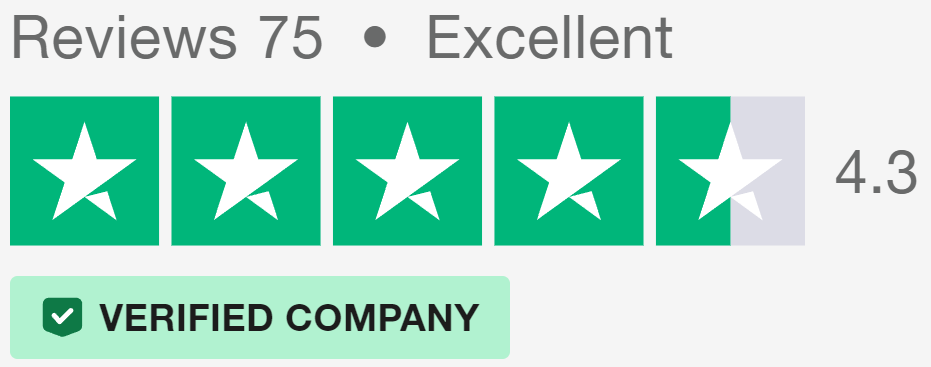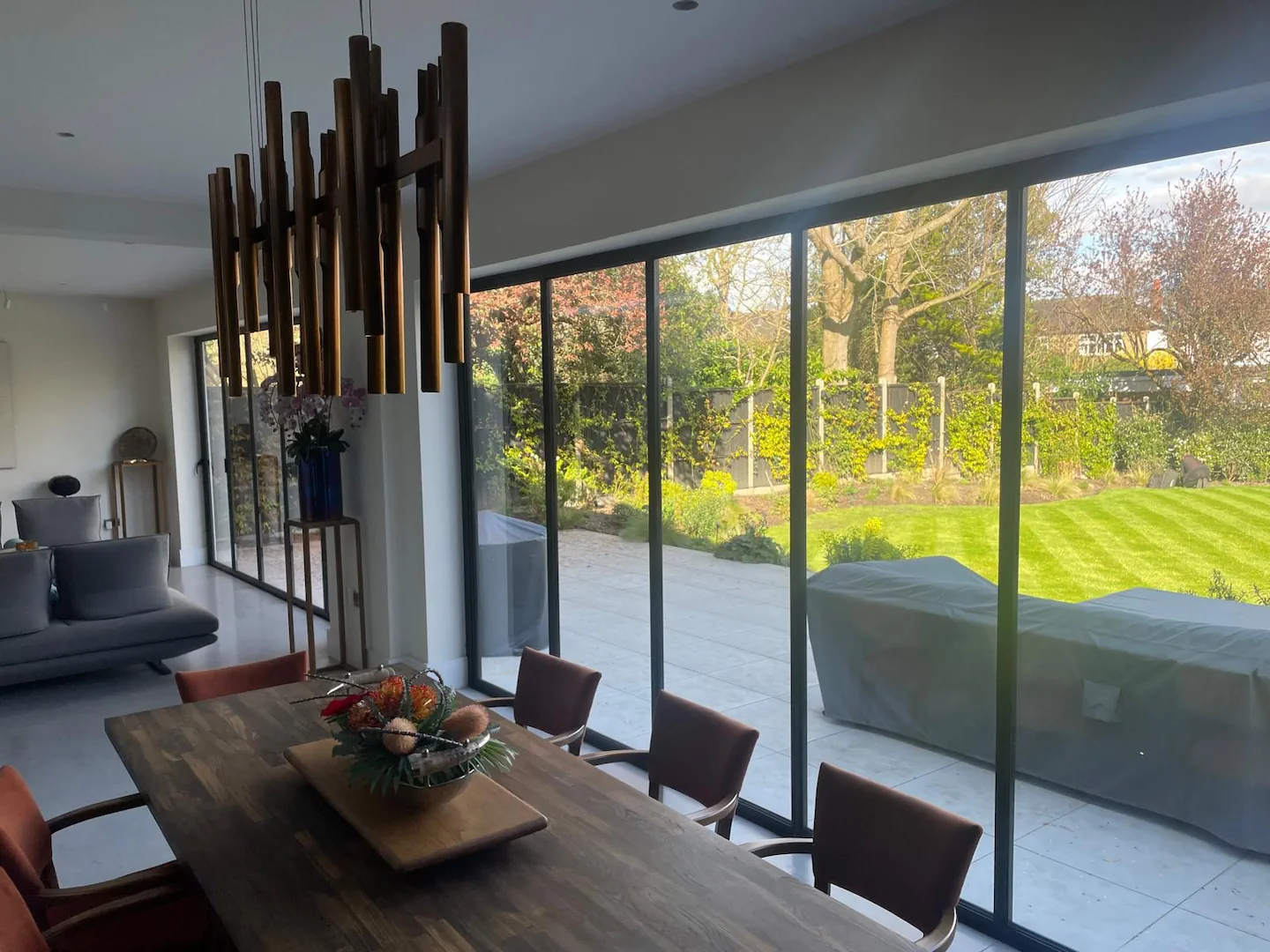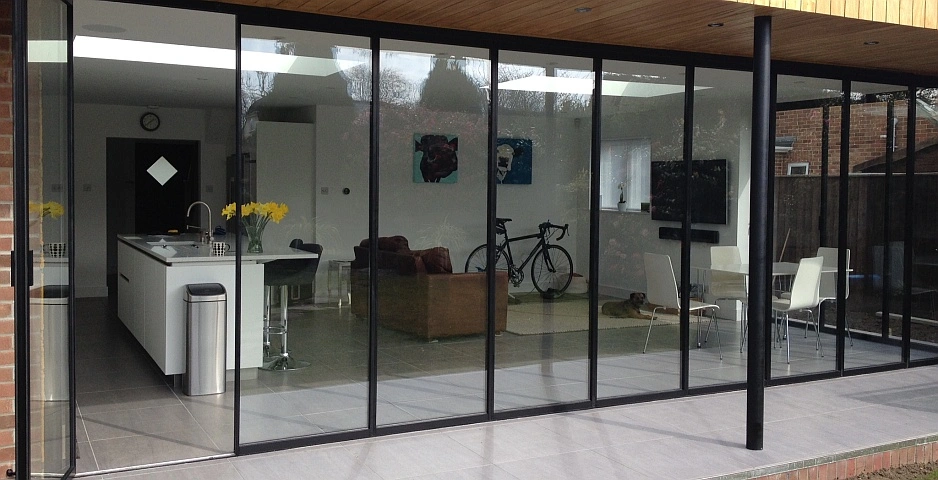Slim Sightline Bifold Doors: Materials & Design Guide
Table of Contents

What Are Slim Sightlines in Bifold Doors?
Bifold doors with minimal frames look vastly different from the chunky aluminium systems common in the 1990s and early 2000s. Slim sightline bifold doors reduce visual barriers between spaces, with frame faces as narrow as 35mm where door panels meet.

Measuring Frame Profiles
Meeting stiles – where two door panels join together – form the most noticeable part of bi-fold doors when closed. The visible width of these profiles determines whether a system qualifies as having slim sightlines. Premium systems cut this meeting stile width nearly in half compared to standard profiles, achieving a more refined look without reducing strength.
Marketing materials often trumpet ever-decreasing frame widths, yet physics and building regulations impose strict limits. Bi-folding doors must withstand substantial wind loads while supporting double or triple glazing. The slimmest profiles available use reinforced aluminium alloys that maintain rigidity despite their minimal size.
Comparing Visual Weight
Standard bifold systems often feature meeting stiles wider than 120mm, creating obvious vertical lines across the view. Slim sightline bifold doors shrink these lines – many premium systems now offer meeting stiles below 95mm. Jamb profiles, which attach to your walls, have also grown more discrete, with some designs reducing visible frame width by over 40%.
Frame-to-Glass Ratios
The proportion of glass to frame reveals the real impact of slim profiles. While conventional bifolds might show frame materials across 15-20% of the surface area, systems with slim sightlines can drop this figure below 12%. This reduction becomes particularly striking on larger installations, where limiting frame interference makes a substantial difference to sight lines and natural light levels.
Designing With Slim Sightline Bifold Doors
Minimal frame profiles change how we perceive spaces, making walls appear to vanish when doors are open or closed. The visual impact becomes particularly noticeable in period properties, where slim sightline bifold doors create a striking contrast with traditional architectural elements.
Glass to Frame Ratios
Floor to ceiling bifold doors showcase the true potential of minimal frames. While standard systems draw attention to their framework, slim profiles shift focus to the views beyond. The reduced visual mass of each panel compounds across wider openings – a four-metre installation might gain nearly half a square metre of glass compared to conventional frames.
Pushing glass panels to the ceiling requires careful balance between frame strength and visual delicacy. Premium aluminium systems achieve this through sophisticated internal reinforcement, letting slim sightline bifold doors span impressive heights without bulky visible supports.

Room Layouts and Door Configurations
Wide bifold doors especially demand thoughtful planning to avoid disrupting furniture placement or traffic patterns. The slimmer profiles of modern systems need less stack space when open, giving you more usable room. A three-metre opening with slim frames might free up 200mm more space compared to standard bifolding doors.
Panel quantity influences how doors stack when open. Slim sightline bifold doors reduce this stack depth through their narrower profiles – each panel takes up less space when folded. For example, a five-panel configuration spanning four metres might stack within 500mm rather than occupying 650mm or more.
Architectural Matches
Contemporary glass extensions particularly benefit from bifold doors with slim sightlines, as minimal frames complement modern architectural features. The reduced visual weight prevents heavy lines from dominating minimal interiors, while maintaining the structural integrity needed for large openings.
Georgian and Victorian properties present unique opportunities for slim sightline bifold doors. These period homes often feature tall ceilings and grand proportions, where traditional frame sizes might seem overly industrial. Slender profiles respect original architectural details while adding modern functionality.
In open-plan spaces, frame size becomes more important as doors form part of your daily sightlines. Slim profiles avoid creating artificial barriers between zones, maintaining spatial flow whether the doors are positioned as internal room dividers or external barriers. The visual lightness of minimal frames works particularly well in kitchen-dining areas, where you might spend several hours each day looking through or past the doors.
Room Types and Applications
Garden rooms and orangeries gain particular advantages from slim framed systems. These spaces revolve around natural light and garden views, making frame size a central design factor. Many homeowners choose slim sightline bifold doors specifically for these light-focused rooms, where every millimetre of frame width counts.
Home offices and studios need careful management of natural light and views. Slim profiles help maintain concentration by reducing visual distractions – instead of noticing chunky frames, your eye moves naturally to the scene beyond. Artists and photographers often prefer minimal frames to avoid distorting their perception of outdoor colours and shapes.
Technical Aspects of Slim Sightline Bifold Doors
Frame Materials
Aluminium remains the primary material for achieving minimal sightlines in bifold systems. High-grade alloys provide exceptional strength-to-weight ratios, letting slim sightline bifold doors support large glass panels without thick visible sections. Steel reinforcement inside these slimmer frames adds structural integrity where needed, particularly around hinges and locking points.
Modern thermal break technology uses polyamide strips between internal and external aluminium sections. Premium systems incorporate multiple chambers within these breaks, improving insulation without increasing frame size.
Weather Performance
Wind load calculations determine the minimum frame strength needed for different sizes and configurations. Slim sightline bifold doors must pass the same rigorous testing as standard systems – holding firm against pressures above 2000 Pascal in severe weather testing. The reduced frame size actually helps in some conditions, presenting less surface area for wind to push against.
Internal drainage channels direct water through concealed paths within the frame, preventing leaks without requiring bulky external covers. Premium systems incorporate these channels invisibly – slim sightline bifold doors maintain their minimal appearance while managing British weather conditions effectively.
Thermal Breaks and Thermal Performance
Multi-chamber thermal breaks create distinct temperature zones within the frame profile. Standard systems often use basic two-part breaks, while premium slim sightline bifold doors incorporate three or more separate chambers. This sophisticated approach prevents heat transfer more effectively than simple barrier methods.
Laboratory testing reveals how well these systems perform in real-world conditions. Modern thermal imaging shows heat patterns across entire door panels, letting manufacturers optimise internal chamber design. The latest generation of slimmer frames achieves A-rated thermal performance despite their reduced size.
Advanced gasket designs complement thermal break technology in premium systems. Rather than adding bulky rubber seals, manufacturers now use low-profile EPDM materials precisely shaped to fill gaps without visible protrusion. These developments let bifold doors with slim sightlines match or exceed the thermal performance of conventional frames.
Style Options for Slim Sightline Bifold Doors
Material finishes and hardware choices shape how minimal frame systems look in your space. External bifold doors need finishes that withstand British weather while matching architectural styles – powder-coated aluminium offers durability without compromising the clean lines of slim profiles.
Frame Colours and Finishes
Textured finishes add subtle depth to slim sightline bifold doors without drawing attention to frame sections. Premium powder coating creates a rich, lasting surface that resists scratching and fading. Marine-grade options provide extra protection in coastal areas, maintaining appearance despite salt exposure.
Recent manufacturing advances have improved metallic finish quality on minimal frames. While standard anodised aluminium can look industrial, modern processes create sophisticated surfaces that complement contemporary architecture. Slim sightline bifold doors often showcase these premium finishes better than conventional systems, as the reduced frame area lets subtle textures stand out.
Dual-colour options let you match different schemes inside and out. The outer frame might wear dark grey to complement external cladding, while internal surfaces feature warmer tones that work with interior palettes. This flexibility proves particularly valuable when bifold doors with slim sightlines connect spaces with distinct design approaches.
Handle Designs and Hardware
Minimal frame systems demand carefully designed hardware that maintains their refined appearance. Premium slim sightline bifold doors incorporate flush handles and discrete locking points, avoiding bulky lever handles that might disrupt clean lines. Some manufacturers develop specific hardware ranges for their slimmer profiles, ensuring every component follows the minimal design approach.
Magnetic catches replace traditional door holders, eliminating visible clips or hooks. These systems hold panels securely when open without requiring visible hardware. The technology works particularly well with slim sightline bifold doors, as reduced frame mass means less force is needed to secure panels.
Security Features
Multi-point locking systems need careful integration into minimal frames. While standard bifolds often use visible shoot bolts, slim sightline bifold doors conceal these mechanisms within the frame.
Handle placement requires extra thought with minimal frames. Traditional lever handles can look oversized on slimmer profiles, leading manufacturers to develop new operating systems. Some premium slim sightline bifold doors use pop-out handles that sit flush when not in use, preserving clean lines without compromising usability.
Glass Specifications
Glass technology has advanced alongside frame design, enabling larger panels without thick supporting structures. Modern sealed units combine multiple glass types to control heat, light, and noise – slim sightline bifold doors can accommodate these sophisticated glazing packages despite their minimal frames.
Solar control glass helps manage temperature without visible tinting. Clear glass with microscopic metal oxide layers blocks unwanted heat while maintaining natural light levels. This technology works particularly well with minimal frame systems, as reduced profiles let more light through around the edges of each panel.
Acoustic performance depends on careful glass specification. Triple glazing with varying glass thicknesses reduces noise transmission more effectively than simple double glazing. Premium slim sightline bifold doors maintain these acoustic properties through precisely engineered seals that don’t require bulky gaskets.
Low-maintenance coatings reduce cleaning needs without changing glass appearance. Self-cleaning technology uses sunlight to break down dirt particles, while hydrophobic treatments help water sheet off more effectively. These coatings work particularly well on minimal frame systems, where larger glass areas make maintenance access easier.
Glass strengthening processes let manufacturers push size limits while maintaining safety standards. Heat-soaking removes impurities that might cause spontaneous breakage, while toughening increases impact resistance. Some bifold doors with slim sightlines now accept glass panels over three metres tall, thanks to these advanced manufacturing techniques.
Choosing the Right Slim Sightline Bifold Doors
Physical space limitations often guide system selection more than pure aesthetics. Structural requirements, opening mechanisms, and daily usage patterns need careful assessment when specifying minimal frame systems for different settings.
Opening Sizes and Limits
Panel width calculations depend on height, glass weight, and local wind conditions. Slim sightline bifold doors typically allow individual panels between 850mm and 1200mm wide, though exact limits vary by manufacturer. Taller installations might need narrower panels to maintain stability, while shorter heights permit wider glass sections.
Corner bifold doors present unique challenges with minimal frames. Meeting angles must maintain thermal performance while providing adequate support for glass weight. Premium slim sightline bifold doors overcome these challenges through sophisticated corner posts that hide structural elements within minimal visible profiles.
Building regulations specify minimum opening widths for fire escape routes. Some bifold doors with slim sightlines incorporate emergency egress features into their design, maintaining safety compliance without compromising visual appeal. Fire-rated options exist for certain configurations, though these might require slightly larger frame sections in critical areas.

Configuration Options
Opening patterns change how minimal frame systems work in practice. Odd numbers of panels provide more flexibility – a three-panel slim sightline bifold doors installation might fold two panels one way with a single panel opening separately for daily access. This approach reduces wear on the main bifold mechanism while maintaining the benefits of minimal frames.
Panel stacking direction influences furniture placement and traffic flow. Systems that stack externally need weather protection but free up internal space. Internal stacking slim sightline bifold doors preserve external aesthetics yet require careful interior planning. Some manufacturers offer hybrid systems where panels split between internal and external stacking.
Traffic Door Requirements
Daily access needs influence system design choices. Traditional traffic doors built into bifold sets often use thicker frames for durability. Modern slim sightline bifold doors overcome this limitation through reinforced sections that maintain minimal visible profiles despite frequent use.
Traffic door positioning affects overall system stability. End panels generally work better as frequent-use doors, reducing strain on the main bifold mechanism. Some premium systems incorporate dedicated hardware for traffic doors, letting them function more like standard entrance doors while matching the minimal aesthetics of the main panels.
Long-term Performance
Usage patterns determine appropriate hardware specifications. Properties with young children might benefit from soft-close mechanisms, while rental properties often need robust locking systems. Premium slim sightline bifold doors incorporate these features without compromising their minimal appearance, using concealed dampers and multi-point locks hidden within frame profiles.
Maintenance requirements change with frame design. Traditional systems often need regular adjustment as buildings settle, while modern slim sightline bifold doors use self-adjusting rollers and floating mullions to maintain smooth operation. Some manufacturers now offer remote monitoring systems that alert owners to potential issues before they become noticeable.
We’d Love to Help You
Vision Glass Doors is a designer, manufacturer, and installer of premium door systems. We are a family run business with over 20 years’ experience and 5,000 installations across the UK.
Our leading range of door systems include Ultra Slim – Slide and Turn Doors, Slimline Sliding Patio Doors and Frameless Glass Doors. Suitable for various internal and external applications, they are applicable to residential and commercial projects.
Click Quick Quote Online for a free quotation within 24 hours. Alternatively, call or email us on 01582 492730 or at info@visionglassdoors.co.uk.

